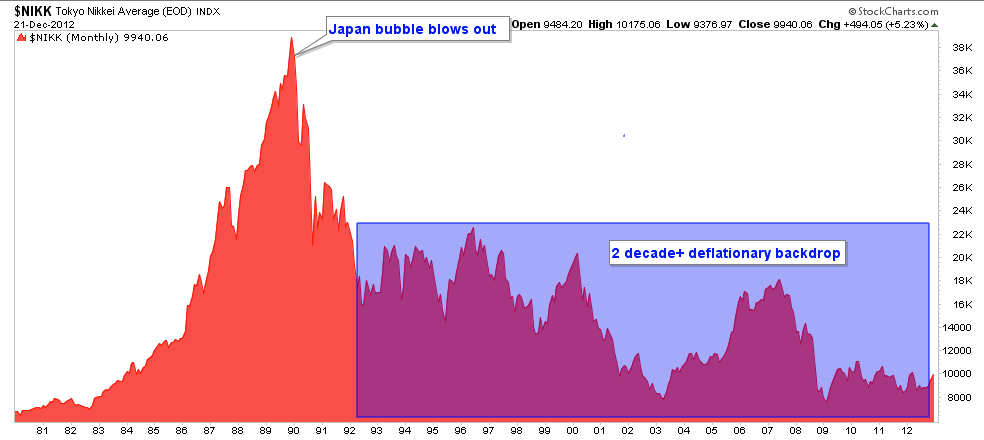Japan is following in the footsteps of the man who laid the groundwork for the greatest global inflationary operation of the modern era. We see the Yen in the top panel of the chart below forming a similar pattern to that which USD made from 2000 to 2002 as an epic bubble in credit expansion was being fomented in the U.S.
The similarity in the charts (with a decade stagger) is striking and it is probably no coincidence that Japan has chosen to leverage its currency -- which had been chronically strong since the 2007 beginnings of the U.S.-triggered global financial meltdown -- just as the US did with the once strong ‘King’ dollar in and around 2001.
According to now widely known macro fundamentals, Japan is following in the America's footsteps. Mr. Shinzo Abe has taken power with a vow to pull Japan out of deflation through “bold economic measures', which is another way of saying 'I have a similar currency setup to t'at of Mr. Greenspan a decade ago and I am going to use it.'
Of course pulling Japan out of deflation is likely to mean that this graph will break to the upside from of a 20+ year consolidation as Japan has apparently voted for higher prices of goods and services.
Ten years ago the 'Greenspan inflation' was still fairly new and U.S. stock markets were mired in a cyclical bear environment. Greenspan and his scheming successor pulled and have kept the U.S. out of what would have likely been a fierce and secular deflationary bear market by employing ever more stimulative money tricks to give us what we have now: diminishing returns and soaring debt loads. A massive bailout of the financially powerful at the expense of the nation’s seed corn and its very future.
Now we have Japan, finally deciding the time is right to join the global party and devour some of its seed corn. But it can be argued that Japan, a country that has routinely been the top global net creditor year after year after year, has enough seed corn to do as it pleases. U.S. citizens should cringe at the thought of what Japan might want to do with some of its massive hoard of Treasury bonds. But that is a story for another day.
The point here is that global policy makers are inflating against a deflationary force that seeks to unwind decades of excess in an over extended and global paper money system. While we wait for the shenanigans in the gold market to play out (as the prime inflationary barometer is put upon by natural and unnatural forces alike), it is worth looking out into the world for more conventional opportunities.
Japan has qualified for a termination to its secular bear market. It may also qualify for an inflationary growth cycle and attendant rising asset markets. The key to remember is the ‘inflationary’ part, because that is what this would be. Just like the thing Greenspan created over a decade ago.
A big difference between the two is that Japan would be initiating its major inflationary operations after a secular and deflationary bear market. In the US, we could not even endure a cyclical bear that followed a massive secular bull without panicking into full on inflation. A future article or NFTRH edition will seek to flesh out the meanings of any differences this could signal, but my gut tells me that Japan’s two decades in the desert will bode well for it on a relative basis to the U.S.
NFTRH uses a model portfolio to try to illustrate and take advantage of some of these global themes, and the Japanese stock market may be part of a balanced plan. The currency swings in the Euro/USD battle and the potentially major turning point in the Yen are likely to provide short and longer term opportunities in 2013. Be ready for change.
- English (UK)
- English (India)
- English (Canada)
- English (Australia)
- English (South Africa)
- English (Philippines)
- English (Nigeria)
- Deutsch
- Español (España)
- Español (México)
- Français
- Italiano
- Nederlands
- Português (Portugal)
- Polski
- Português (Brasil)
- Русский
- Türkçe
- العربية
- Ελληνικά
- Svenska
- Suomi
- עברית
- 日本語
- 한국어
- 简体中文
- 繁體中文
- Bahasa Indonesia
- Bahasa Melayu
- ไทย
- Tiếng Việt
- हिंदी
Japan's Market: Following In U.S. Footsteps
Published 12/26/2012, 12:30 PM
Updated 07/09/2023, 06:31 AM
Japan's Market: Following In U.S. Footsteps
Latest comments
Loading next article…
Install Our App
Risk Disclosure: Trading in financial instruments and/or cryptocurrencies involves high risks including the risk of losing some, or all, of your investment amount, and may not be suitable for all investors. Prices of cryptocurrencies are extremely volatile and may be affected by external factors such as financial, regulatory or political events. Trading on margin increases the financial risks.
Before deciding to trade in financial instrument or cryptocurrencies you should be fully informed of the risks and costs associated with trading the financial markets, carefully consider your investment objectives, level of experience, and risk appetite, and seek professional advice where needed.
Fusion Media would like to remind you that the data contained in this website is not necessarily real-time nor accurate. The data and prices on the website are not necessarily provided by any market or exchange, but may be provided by market makers, and so prices may not be accurate and may differ from the actual price at any given market, meaning prices are indicative and not appropriate for trading purposes. Fusion Media and any provider of the data contained in this website will not accept liability for any loss or damage as a result of your trading, or your reliance on the information contained within this website.
It is prohibited to use, store, reproduce, display, modify, transmit or distribute the data contained in this website without the explicit prior written permission of Fusion Media and/or the data provider. All intellectual property rights are reserved by the providers and/or the exchange providing the data contained in this website.
Fusion Media may be compensated by the advertisers that appear on the website, based on your interaction with the advertisements or advertisers.
Before deciding to trade in financial instrument or cryptocurrencies you should be fully informed of the risks and costs associated with trading the financial markets, carefully consider your investment objectives, level of experience, and risk appetite, and seek professional advice where needed.
Fusion Media would like to remind you that the data contained in this website is not necessarily real-time nor accurate. The data and prices on the website are not necessarily provided by any market or exchange, but may be provided by market makers, and so prices may not be accurate and may differ from the actual price at any given market, meaning prices are indicative and not appropriate for trading purposes. Fusion Media and any provider of the data contained in this website will not accept liability for any loss or damage as a result of your trading, or your reliance on the information contained within this website.
It is prohibited to use, store, reproduce, display, modify, transmit or distribute the data contained in this website without the explicit prior written permission of Fusion Media and/or the data provider. All intellectual property rights are reserved by the providers and/or the exchange providing the data contained in this website.
Fusion Media may be compensated by the advertisers that appear on the website, based on your interaction with the advertisements or advertisers.
© 2007-2024 - Fusion Media Limited. All Rights Reserved.
